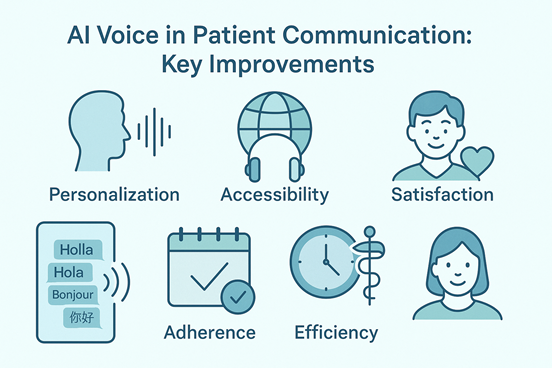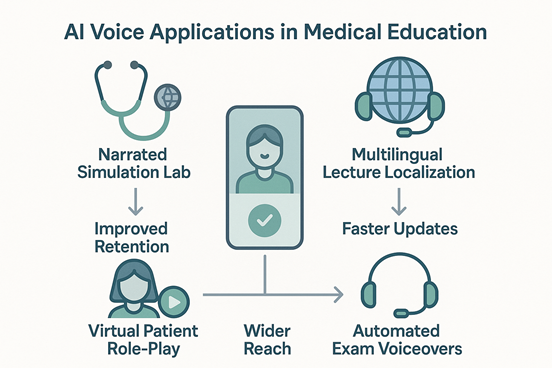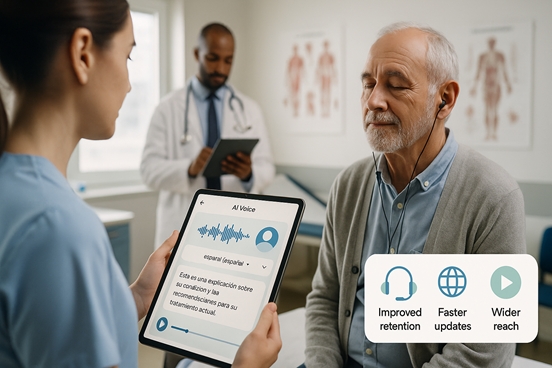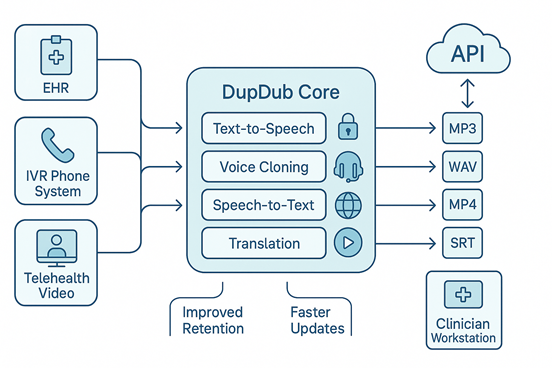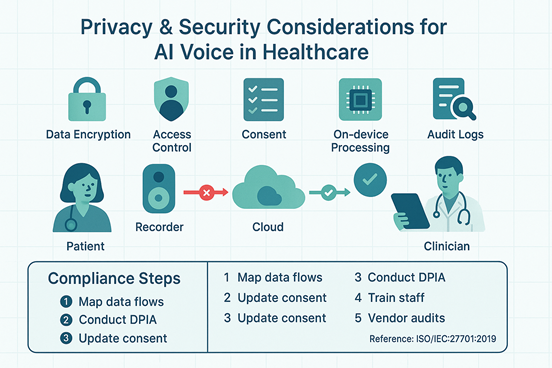AI voice for healthcare is changing how clinicians and patients communicate. It enables multilingual audio, accurate speech-to-text (automated transcription), and personalized voice prompts that cut confusion and boost adherence. Here’s the bottom line: these tools speed workflows and improve patient understanding.
Platforms now deliver clear patient instructions, automated visit summaries, and medication reminders in many languages. They also free clinicians from repetitive tasks by automating notes and translations. Patients get consistent, friendly voices that lower anxiety and improve follow-through.
DupDub and similar platforms turn written guidance into natural voiceovers, support voice cloning for branding or clinician consistency, and add subtitles and translation. Key gains:
-
Multilingual reach and accessibility
-
Personalized, consistent patient interactions
-
Time savings, better accuracy, faster education and training
Introduction to AI Voice Technologies in Healthcare
AI voice for healthcare is changing how patients and staff communicate. These systems convert text to spoken words and spoken words to text. They save time and lower friction in patient workflows.
How it works: core components
AI voice systems combine a few core technologies. Text-to-speech (TTS) turns written content into natural speech. Speech-to-text (STT) transcribes spoken words into text for records. Voice cloning recreates a specific voice for consistent messaging. Natural language understanding (NLU) helps the system interpret intent and respond.
Here's the bottom line:
-
Text-to-speech (TTS): creates clear spoken instructions and education.
-
Speech-to-text (STT): captures notes and patient responses accurately.
-
Voice cloning: preserves trusted clinician tones for patient follow-up.
-
NLU and routing: routes requests to live staff or automated paths.
Real-world mini-scenario
Imagine Maria, a 68-year-old patient leaving a clinic. She gets a friendly voice call that explains wound care and when to take meds. The voice explains simply, asks if she understands, and logs her reply for the care team.
For executives, this foundation shows where voice can cut costs, raise adherence, and improve patient experience. Next, we’ll dig into patient-facing benefits and training impacts.
Benefits of AI Voice in Patient Communication
AI voice for healthcare makes patient talks clearer and more personal. It helps teams send the right messages at the right time. This section shows how voice tech can boost access, understanding, and outcomes.
Personalize messages at scale
AI voice brings a consistent, human tone to routine messages. Providers can tailor messages by age, language, and level of medical detail. Platforms like DupDub offer large voice libraries and multiple accents to match patient needs.
-
Personal greetings in a familiar tone
-
Condition-specific phrasing for clarity
-
Voice styles that match patient age or culture
Make care more accessible
Voice systems read instructions aloud, so low-literacy patients get help. They also translate and localize audio into other languages. Here’s a mini scenario: Maria, 72, gets a surgery prep call in her native language. She hears clear steps, asks one question, and shows up ready. That small change cut her anxiety and made her follow instructions better.
Improve adherence and satisfaction
Automated voice reminders lower missed appointments and missed meds. They work 24/7 and free staff time for complex care. Here’s the bottom line: better communication drives better outcomes.
Benefits at a glance:
-
Personalization: tailored tone and content
-
Accessibility: multilingual audio and simple phrasing
-
Consistency: identical instructions every time
-
Efficiency: fewer calls for staff, more follow-through
-
Comfort: familiar voices increase trust
AI voice also helps caregivers and remote teams. For example, a rehab coach can send motivational audio clips to a patient in their preferred voice. That keeps patients engaged between visits.
Overall, voice AI can make routine communication feel human again. When tech focuses on people, care improves and patients feel heard.
Enhancing Medical Education with AI Voice
AI voice for healthcare is changing how clinicians learn. Educators use voice AI to narrate tutorials, run simulated patient interviews, and add consistent narration to microlearning modules. DupDub's voice cloning (copying a speaker's voice) and broad language support make it simple to create realistic, repeatable lessons that work across regions.
Run realistic simulations with voice
Voice-driven simulations make skills practice active and repeatable. Narrated case studies let learners hear patient cues and practice responses. Mini-scenario: a med student practices a telehealth intake. The AI plays a worried patient, and the student records responses. This turns passive reading into interactive role-play, which boosts retention.
Scale learning and reach more learners
AI voice tools let teams localize content fast. Use cases include:
-
Multilingual lectures for diverse cohorts.
-
Consistent voiceovers for standardized exams and onboarding.
-
Rapid updates of guidelines without re-recording live actors.
These tasks are faster with platforms that offer many voices and languages, and that keep a brand voice consistent.
Here’s the bottom line: AI voice tools let educators create interactive, repeatable, and multilingual learning at scale. They reduce production time and keep teaching consistent across cohorts. Try adding short voiced simulations to a module and measure learner engagement—it's an easy win for medical training.
Case Studies: Success Stories in Healthcare
Real-world examples show how ai voice for healthcare improves care and learning. This section highlights deployments that raised clarity, cut time, and helped diverse patients. You’ll see practical uses and a small hospital scenario.
Speed triage and detect strokes early
-
Faster assessments at first contact
-
Clearer handoffs to hospital teams
-
Reduced call-backs for clarification
-
Better detection of high-risk cases
Teach patients and train staff with clear voice content
A community clinic used TTS (text-to-speech) and voice cloning to create multilingual discharge guides. A nurse played a native-language briefing for an elderly patient. The patient repeated the steps, and the nurse logged success. DupDub powered content creation, letting staff make quick, brand-consistent voiceovers and translated subtitles.
Here’s the bottom line: teams said patients understood instructions better and staff saved time. In another mini-scenario, clinicians used voice-guided modules to train new hires. That made onboarding faster and learning more consistent.
Hospitals can use these cases as a template. Start small, test accuracy, collect feedback, and scale what works. Real user quotes and outcome data help secure buy-in and guide safe deployments.
Product Integration: How DupDub Powers Voice Solutions in Healthcare
DupDub makes deploying ai voice for healthcare practical and fast. The platform turns scripts, patient education, and clinical guidance into natural, localized audio. Teams can use voice cloning and text-to-speech (TTS) to scale consistent messaging across patients and staff.
Embed voice across workflows
DupDub plugs into common clinical channels. You can add voice content to patient portals, automated phone systems, telehealth platforms, and learning management systems. That means the same clinician voice can narrate a discharge script, a training video, and a follow-up call.
Key integration points:
-
API access for automated generation and delivery.
-
Multilingual TTS and voice cloning for diverse patient populations.
-
Subtitle and translation flows for video-based training.
-
Export formats (MP3, WAV, MP4, SRT) for system compatibility.
Mini scenario: A nurse records a clear discharge summary. DupDub clones that caregiver voice. The system generates translated audio files for three languages. Patients get a friendly, consistent voice message at home.
Secure, compliant deployment
Healthcare teams need privacy and control. DupDub encrypts voice data and allows only verified speakers for cloning. Federal guidance highlights guardrails: the VA's
VA Trustworthy AI Framework 2023 emphasizes safety, security, privacy, and equity in AI use. Providers can combine DupDub with existing access controls and audit logs to meet local compliance.
Here’s the bottom line: DupDub can speed production and keep control of sensitive audio assets. It reduces manual recording time and keeps voice branding consistent. Want to cut translation time or standardize counseling scripts? DupDub supports those exact goals while fitting into clinical tech stacks.
Benefits at a glance:
-
Faster patient communication and lower staff workload.
-
Better access for non-English speakers and low-literacy patients.
-
Scalable training content for clinicians and staff.
DupDub works as a creative engine and a systems tool. That mix helps healthcare teams deliver clearer, faster, and more inclusive voice communication as they adopt voice AI in healthcare.
Challenges and Considerations: Privacy, Security, and Compliance
Implementing ai voice for healthcare raises real privacy and security questions. Patients share Protected Health Information (PHI) in voice form, so systems must guard it. This section looks at risks, simple controls, and practical steps teams can take.
Secure data, protect trust
Voice files can include PHI (Protected Health Information). That means sounds, transcripts, and metadata need safeguards. Start with basic controls that reduce exposure.
-
Encrypt data at rest and in transit. Use strong keys and rotate them often.
-
Limit access by role. Log and review every access event.
-
Obtain clear patient consent for voice capture and use.
-
Prefer on-device processing when possible to cut cloud risk.
Mini-scenario: A clinic records discharge instructions for a non-English patient. The recording includes diagnosis details. The team encrypts the file, stores it in a protected folder, and shares a one-time link with the patient. That small workflow cut risk and improved follow-up.
Follow standards and compliance
Map workflows to relevant laws and standards. Use privacy frameworks to make requirements clear. Adopt privacy frameworks like ISO/IEC 27701:2019 (
International Organization for Standardization, 2019) to extend information security into privacy. That gives a repeatable way to manage consent, retention, and breach response.
Follow these steps to align with rules:
-
Run a data-flow map to find where voice data moves.
-
Do a privacy impact assessment for high-risk uses.
-
Update policies and patient consent forms.
-
Train staff on voice-specific risks and response plans.
-
Use strong vendor contracts and right-to-audit clauses.
How DupDub helps
DupDub offers security features that match these controls. It encrypts voice data and limits voice cloning to the original speaker. DupDub also states voice data is not used for third-party training. APIs and enterprise settings give access controls and logging. These features help teams meet privacy rules without slowing workflows.
Here’s the bottom line: treat voice like any other sensitive data. Use standard controls, document flows, and pick vendors with clear privacy practices. Do that and voice AI can improve care without adding undue risk
Future Outlook: The Next Wave of Voice AI in Healthcare
AI voice for healthcare will become more proactive, personal, and multilingual. Early wins come from better natural language processing (NLP) (natural language processing) and real-time synthesis. Platforms that combine text, voice, and video will scale clinical education and patient outreach with less friction.
Emerging trends and innovations
Here’s the bottom line: voice systems will move from scripts to context-aware helpers. Expect these shifts:
-
Personalized coaching at scale. AI will tailor medication reminders and rehab prompts to a patient’s language and tone. This improves adherence and comfort.
-
Real-time translation and localization. Multilingual voice tools will let clinicians explain care to patients in native accents. That cuts misunderstandings.
-
Clinical decision support via voice. Clinicians will get quick voice summaries of records and guidelines during exams.
-
Immersive training with lifelike narration. Medical learners will practice with realistic simulated patients voiced by AI.
How providers can prepare
Start small and test in low-risk areas like patient education and training. Train staff on voice ethics and consent. Use platforms that protect voice data and let teams scale audio assets. For example, a small clinic used voice narration for discharge plans: patients replayed instructions at home and ER visits fell. That mini-win drove wider adoption.
Voice AI will boost access, speed, and learning if teams plan for privacy and quality. Keep human oversight, measure outcomes, and iterate quickly. The next wave is practical, measurable, and patient-focused.
FAQs
-
What is ai voice for healthcare and how is it used?
AI voice for healthcare means using AI to generate or understand spoken language. It covers text-to-speech, voice cloning, and speech-to-text. Providers use it for patient reminders, accessibility, and narrated patient education.
-
How secure is voice ai healthcare for patient data?
Security depends on provider controls and consent. Look for encryption, access logs, and clear consent flows. Also check for compliance with local health rules like HIPAA (US privacy rule). Vendors should offer data isolation and options to avoid third-party training.
-
Can ai in healthcare replace clinicians or staff?
No. It augments care and saves staff time. For example, a nurse used an AI voice tool to send pill reminders to elderly patients. That freed the nurse for complex calls and cut missed doses. AI handles routine tasks, humans handle judgment.
-
How do we implement ai voice for healthcare in our system?
Start small and scale. Follow these steps: 1. Pilot one use case, like medication reminders. 2. Validate accuracy and patient acceptance. 3. Integrate with EHR (electronic health record) and workflows. 4. Train staff and monitor outcomes.
-
What benefits do patients and educators see from ai voice in healthcare training?
Patients get clearer, consistent messages in their language. Educators can create narrated lessons and multilingual simulations fast. That improves retention and access for nonnative speakers.
-
What should we ask vendors about voice AI healthcare solutions?
Ask about voice quality, language support, and latency. Check security, privacy policies, and whether only the original speaker can upload voice data. Also ask about APIs for automation and real-world proof of clinical value. Here's the bottom line: pick a partner with strong security, easy integration, and clinical use cases you can test.
